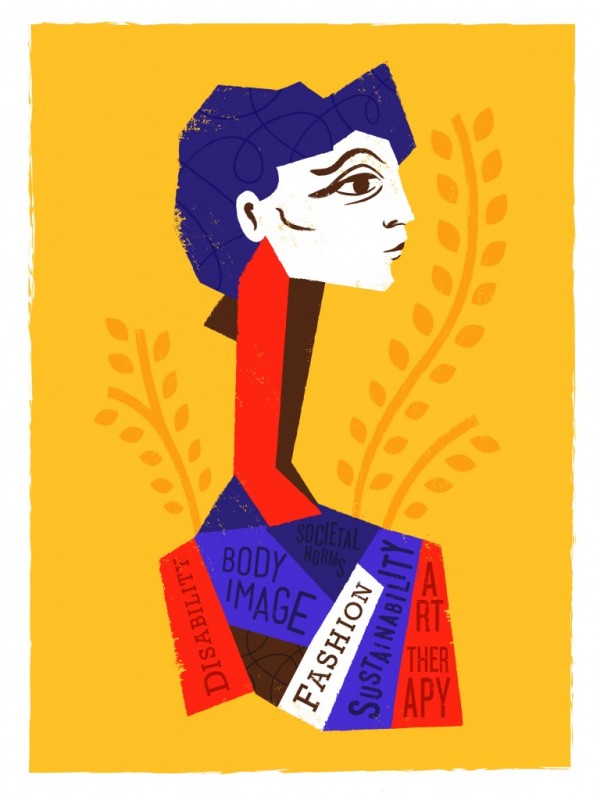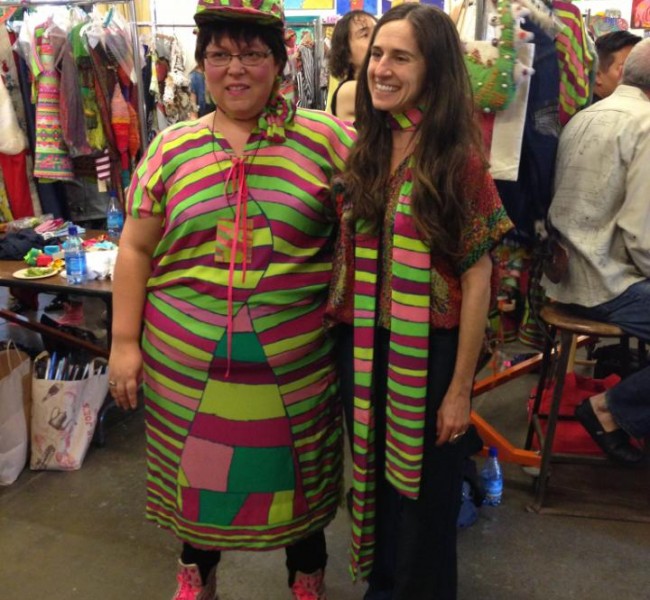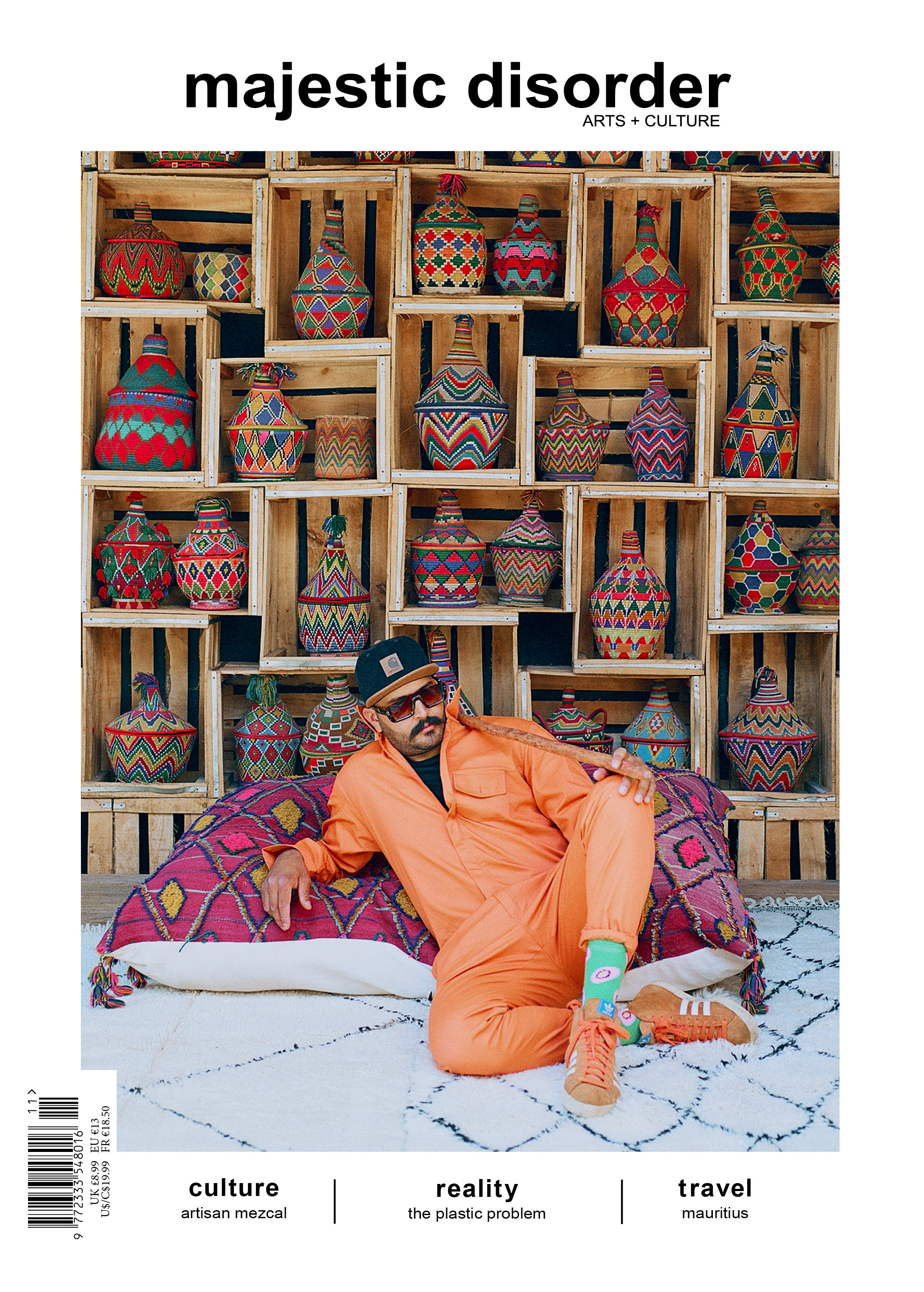the armor to survive everyday life
When fashion, sustainability and art therapy intersect
Illustration By Carmi Cioni
Worlds apart from high street conglomerates and fashion week monstrosities clad in their Brian Lichtenberg slogan sweatshirts, sneaker wedges and jackets from the latest Topshop collaboration, Sandie Yi’s Crip Couture collection is taking back the reins and redefining how we construct our standards of beauty and social perceptions. An avant-garde wearable art project, Crip Couture represents the road less traveled where art, psychotherapy and fashion all intersect.
Born with two fingers on each hand and two toes on each foot, Sandie’s disability came attached with many cultural stigmas. Throughout her childhood, doctors frequently encouraged Sandie’s mother to have her “fixed,” alluding this would lead her to society’s theoretical promised land where she’d “fit in and be normal.” For some, her disability may not seem overtly abnormal, but her work is anything except ordinary.
Sandie, an art therapist originally from Taiwan and now based in Chicago, uses her designs as an outlet in a niche movement within the therapeutic world known as art therapy. The concentration steps outside the realm of what has traditionally defined the field and forces us to reexamine our relationship to fashion, art, sustainability, responsibility and societal norms.

“In art therapy, we use art to explore and understand personal experiences. In my case, it was about disability, body image and the oppressive messages and experiences that had shaped my understandings of society and myself,” Sandie explained. “For me, making gloves, shoes and accessories for my own hands and feet is a way to reconnect with my body, memories and integrate my full sense of self.”
Each piece Sandie designs is solely based on “an individual’s medical experience, state of mind, and physical position.” Her vigorous artistic approach is a call to arms to reverse the way we see ethics, aesthetics and their affiliation to disability and the body.
“I think that the process is so deep, so painful, but it is fulfilled with layers of growth. It helps me to take action and imagine the impossible in the sense of, what can I do about it? What can I do about the society not wanting my kind of body, my disabled body,” said Sandie.
Art therapy has traditionally utilized creative avenues such as painting, sculpting and writing to aid in one’s healing and development. Recently though, many art therapists have pursued fashion design as another creative avenue that is equally beneficial and rewarding.

Savneet Talwar, an art therapist and chair of the School of the Art Institute Chicago art therapy program, has taken things a step further by not only injecting a fashion element into her practices but also a sustainable one often involving a DIY type of setting.
Starting her career as a psychotherapist Savneet describes her first life as an art therapist as one where she often felt frustrated dealing with poorer clients whose economic needs were out of her hands.
“Completing a PhD in American Studies opened up a lot of ideas for me in relationship to social and cultural practices. I started questioning cultural differences and asking myself can we give someone therapy without giving them any kind of economic stipend?” Savneet said.
In collaboration with the Hamdard Center, Savneet holistically weaves together her approach with immigrant women of Bosnian, South Asian and Middle Eastern descent who come from various social and economical backgrounds. Uniting these women who possess gender labeled practices that are no longer valued such as sewing, knitting and crocheting, Savneet provides a space where they can come reengage with these practices and mine memories by revisiting and investigating cultural trauma.
“For me therapy’s not always about sitting in and saying let’s have a treatment plan. What I think is happening is that there’s a lot of sharing happening on an informal level. People getting to know each other through the act of creating,” Savneet said. “The therapy happens out of the blue through the making of the garments. It’s a very easy place to get back to that time of childhood instead of someone in a traditional therapy setting asking you about your childhood.”
Using recycled materials from SAIC’s fashion department, Savneet is bringing craft and fabrication as a form of economic, gender and social justice. Everything produced at the studio is geared towards economically supporting the women with 70% of the proceeds going to them and 30% to keep the studio going.
“My work is very much about a social model of art therapy. I’m interested in how art therapy can be a form of empowerment, a form of support for individuals. I’m not interested in the punitive measures of things. I’m interested in how we can support people, how we can support communities and how do we conquer what we’re doing in our daily lives in a sustainable manner.” Savneet said.
For Savneet, who came into the field by default as a potter interested in therapeutic practices, the end goal is about paying the women to come to the group instead of them having to pay to be there. It’s about valuing their skills and seeing how they can be used to aid them therapeutically and economically.
“In our culture in the U.S. we don’t look back on craft skills as something important. If we truly want to think about uplifting people we can’t keep marginalizing them further,” Savneet said.

Although the therapeutic medium remains relatively obscure from the mainstream, those recognizing its merits are increasing. Erica Tanov, a Berkeley, California based fashion designer, saw the potential of art therapy and the power behind mixing it with fashion.
For her SS13 collection Erica collaborated with artists at Creative Growth Art Center, a non-profit in Oakland, California dedicated to supporting artists with disabilities, to bring their current and archival works to life.
“Working with their artwork and applying it to a completely different medium (clothing and housewares), giving the work new life and seeing in a different context, was so rewarding,” Erica explained. “I found Creative Growth to be such an inspiring and passionate place. I wanted to somehow be a part of what they do. Collaborating and working with the artists’ work was a way for me to be part of their creativity, energy and passion.”
Despite endeavors like this pursued by Sandie, Savneet and Erica, mixing fashion and art therapy still remains in its infancy.
“The field has a lag time. It’s been so busy trying to establish its legitimacy as a psychotherapy practice that the art part of things has gotten short chipped,” said Cathy Moon, an associate professor and director at SAIC’s art therapy program.

“I suspect fashion is being incorporated into more and more practices. There are already people who use their fashion design and clothing just like the way people use any kind of body adornment like tattoos. They use it to express themselves, to address things that have happened in their lives. Body adornment is a way you navigate that relationship between the inner person and the outer world. Trauma is not accessibly through words.”
The need for furthering art therapy has been advocated by the American Art Therapy Association, which was founded in 1969. Dr. Patricia Isis, an art therapist based in Miami, has worked with the association since 1978. Patricia stresses the value and need of art therapy in today’s culture as she witnesses its transition being based full time in Miami-Dade County public schools.
“In a lot of the kinetic family drawings that I see now the computer or the TV holds a dominant place and they look like they’re a member of the family. It’s not gender specific at all. It’s culture specific. Kids don’t go outside anymore. There’s no interaction with nature, much less another person. Art education has to be more widely distributed,” Patricia said.
With a conundrum of exciting ideologies and various mediums being used, the camaraderie among the industry professionals and fashion’s expanding noble role is undeniable. Although no two art therapists approach the field the same, they’re all striving to draw attention to fashion’s taboo relationship with disability, sustainability, body acceptance and social justice.
“I’m so madly in love with this field. Each session is always different. I’m blown away daily by what I see. That’s the refreshing nature of art is that there is no rigidity,” Patricia concluded.
(Images courtesy of Sandie Yi and Erica Tanov)
Related Reading







 @majesticdisorder
@majesticdisorder